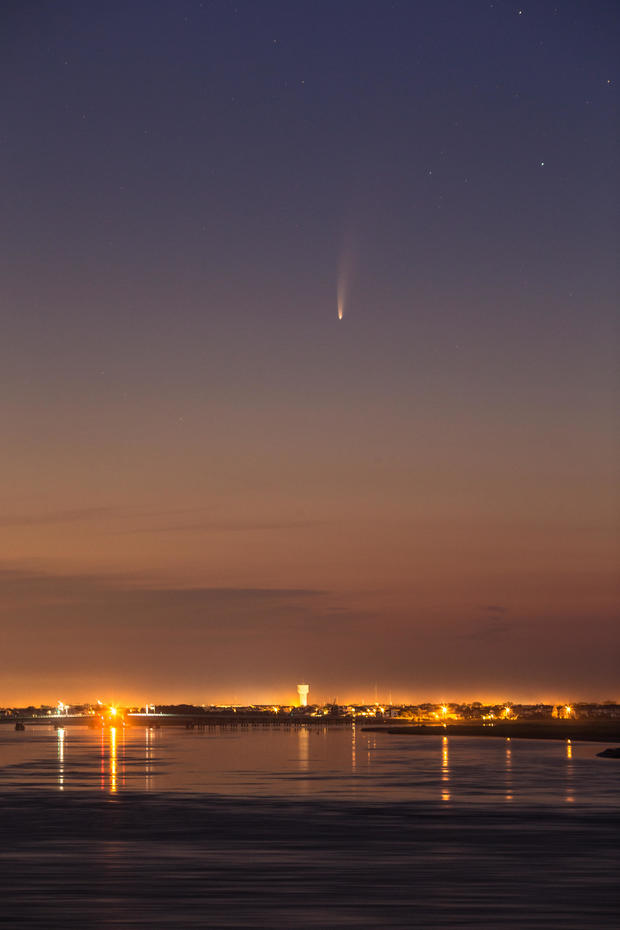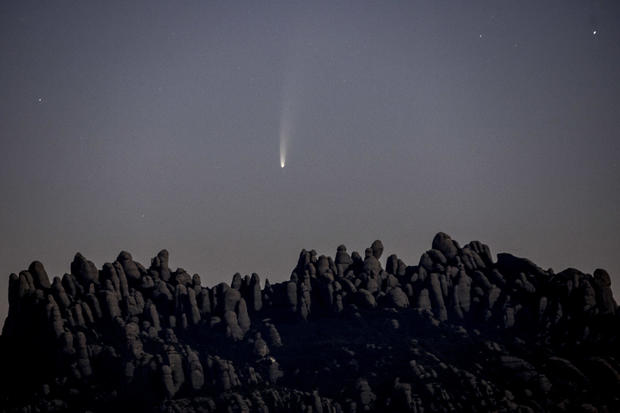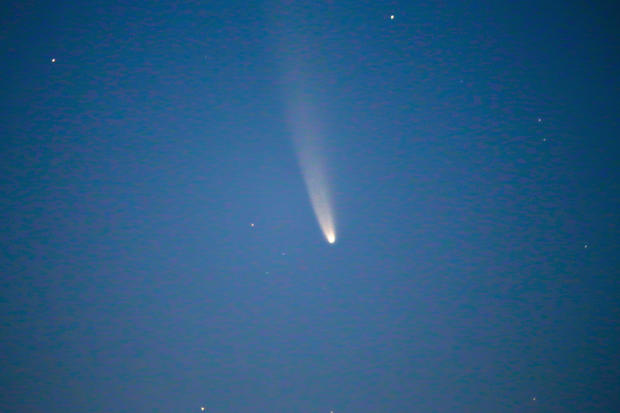On July 3, Neowise was closer to the sun than the orbit of Mercury, coming dangerously close to breaking apart. The sun heated up much of the comet's icy makeup, erupting in a large debris trail of gas and dust.
Measuring about 3 miles across, Neowise is considered a fairly large comet — providing skywatchers with a spectacular view from Earth. It's made up of material dating back to the origin of our solar system, 4.6 billion years ago, scientists said.
The event is truly a once-in-a-lifetime experience — the comet takes about 6,800 years to complete its path around the sun, according to NASA.
"In its discovery images, Comet NEOWISE appeared as a glowing, fuzzy dot moving across the sky even when it was still pretty far away," Amy Mainzer, principal investigator at the University of Arizona, said in a news release this week. "As soon as we saw how close it would come to the Sun, we had hopes that it would put on a good show."
The comet, which has a bright opulent tail, has been putting on a stunning show in the early hours before sunrise in the Northern Hemisphere. Astrophotographers have captured breathtaking images of the comet, as have astronauts aboard the International Space Station .
But late sleepers need not worry — the comet will start appearing in the evening, just after sunset, starting Saturday. To view it, people in the Northern Hemisphere can look to the northwestern sky, just below Ursa Major, commonly known as the Big Dipper constellation.
Scientists say the comet will be visible across the Northern Hemisphere for about another month. In conditions with little light pollution, it may be visible with the naked eye, but NASA recommends using binoculars or a telescope to spot its long tail.
New Jersey
Comet Neowise photographed from North Wildwood, New Jersey, on July 8, 2020. CHRIS BAKLEY Spain
Neowise is seen above the mountain of Montserrat, near Barcelona, Catalonia, Spain, on July 9, 2020. ALBERT LLOP/NURPHOTO VIA GETTY IMAGES Turkey
Neowise is seen above Turkey's Van province on July 11, 2020.
Newowise's closest approach to Earth comes on July 22, at a distance of about 64 million miles. NASA said it's "no Hale-Bopp," the spectacular comet of 1997, but it will be one of the brightest this century.
NASA added it will become even easier to view as July continues, for skywatchers with a clear view toward the horizon. The comet appears higher in the sky for observers farther north, while observers at lower latitudes will view it lower in the sky.
It will be about 7,000 years before the comet returns, so skywatchers shouldn't hesitate to seek out the natural fireworks display.
The Comet NEOWISE or C/2020 F3 is seen above Salgotarjan, Hungary, early Friday, July 10, 2020.
Quelle: CBS News
+++
Spectacular photos capture Neowise, one of the brightest comets in decades Neowise, one of the brightest comets in decades, has brought with it a stunning debris trail this month, delighting skywatchers around the world. Even astronauts aboard the International Space Station have captured the stunning celestial phenomenon, which promises to bring even more spectacular sightings as the month goes on.
During the month of July, the newly-discovered comet Neowise, formally named Comet C2020 F3 NEOWISE by NASA , has been visible in the early hours before sunrise. Early risers have captured already captured breathtaking images of the event.
The event is truly a once-in-a-lifetime experience — the comet takes about 6,800 years to complete its path around the sun, according to NASA. Starting this weekend, it will be visible to viewers in the Northern Hemisphere in the evening, just after sunset.
Czech Republic
Comet Neowise streaks above Brno, Czech Republic before daybreak on July 10, 2020. MILOSLAV DRUCKMULLER (BRNO UNIVERSITY OF TECHNOLOGY) Italy
Comet Neowise shining at sunset above the Port of Molfetta in Molfetta on July 11, 2020.
French Alps
Neowise is seen in the eastern French Alps, along with noctilucent clouds, on July 8, 2020. EMMANUEL PAOLY Hungary
The Comet NEOWISE or C/2020 F3 is seen above Salgotarjan, Hungary, early Friday, July 10, 2020. PETER KOMKA/AP International Space Station
Neowise is seen from the International Space Station on July 5. NASA, ISS EXPEDITION 63 China
China
Comet Neowise observed from Beijing, China on July 7, 2020. COSTFOTO/BARCROFT MEDIA VIA GETTY IMAGES
New York
New Jersey
Comet Neowise photographed from North Wildwood, New Jersey, on July 8, 2020. CHRIS BAKLEY Spain
Neowise is seen above the mountain of Montserrat, near Barcelona, Catalonia, Spain, on July 9, 2020. ALBERT LLOP/NURPHOTO VIA GETTY IMAGES Turkey
Lebanon
Neowise is seen over Lebanon just before sunrise on July 5, 2020.
Quelle: CBS News



